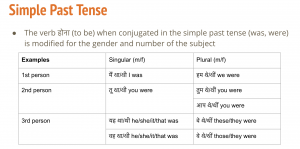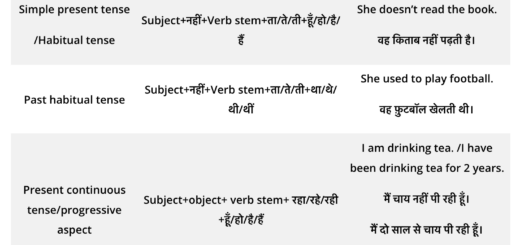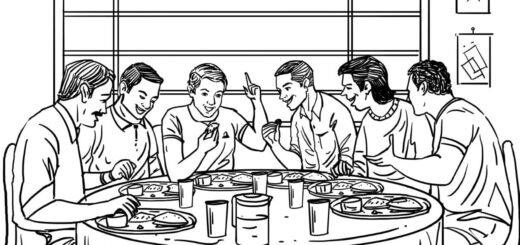Review Elementary Hindi 101
Lesson 1-8
Hindi alphabet cheat sheet -Link
Lesson-1
✅ Word Order: Subject + Object + Verb
| Hindi Sentence | Meaning | |
|---|---|---|
| मैं ठीक हूँ। | I 🙋♂️am fine😊 . | |
| मेरी किताब मोटी है। | My book📘 is thick📏. |
❌ Negative Sentence Structure
Negatives are placed before the verb.
| Hindi Sentence | Meaning | |
|---|---|---|
| यह मौसम ख़राब नहीं है। | This weather 🌦️ is not❌ bad😣. |
Asking questions:
❓ What = क्या
What is your name?
आपका नाम क्या है?
- आपका नाम = your name
- क्या = what
- है = is
🧠 Structure:
Subject (आपका नाम) + Question word (क्या) + Verb (है)
✅ Yes/No Questions with क्या
In Hindi, क्या is also used at the beginning of yes/no questions.
Example 1:
Are you Indian?
क्या आप हिंदुस्तानी हैं?
🇮🇳🙋♀️ ❓
- क्या = question marker
- आप = you
- हिंदुस्तानी = Indian
- हैं = are
🧠 Structure:
Question marker (क्या) + Subject (आप) + Predicate (हिंदुस्तानी हैं)
Example 2:
Is it a home?
क्या यह एक घर है?
🏠❓
- क्या = question marker
- यह = it
- एक घर = a home
- है = is
🧠 Structure:
Question marker (क्या) + Subject (यह) + Object (एक घर) + Verb (है)
Lesson 1 – Vocabulary
Lesson-2
postposition का/के/की -Link
- का, के, की is based on the number and gender of the object or person possessed, not the possessor
- The order of the phrase is always the same!
- Possessor + का, के, की + object/person possessed
Pronoun
Personal pronouns and present forms of होना verb
| person | Singular | verb | Meaning | Plural | Verb | Meaning |
| 1st | मैं | हूँ | I am | हम | हैं | We are |
| 2nd | तू | है | You are | तुम | हो | You are |
| आप | हैं | You are | ||||
| 3rd | यह | है | This, it
he, she is |
ये | हैं | These
They, He/She(hon.) are |
| वह | That
He, she is |
वे | Those
They, are |
Using “का / के / की” to Show Possession in HindiIn Hindi, “का“, “के“, and “की“ are postpositions used to indicate possession. They function similarly to the English possessive ’s (as in Raj’s book).
The form (का / के / की) depends on the gender and number of the thing being possessed, not the possessor. |
| सर्वनाम (Pronoun) | का form (Pronoun + का) | के form (Pronoun + के) | की form (Pronoun + की) |
| मैं (I) | मैं + का = मेरा (my) | मैं + के = मेरे | मैं + की = मेरी |
| हम (we) | हम + का = हमारा (our) | हम + के = हमारे | हम + की = हमारी |
| तुम (you) | तुम + का = तुम्हारा (your) | तुम + के = तुम्हारे | तुम + की = तुम्हारी |
| आप (you) | आप + का = आपका (your) | आप + के = आपके | आप + की = आपकी |
| तू (you) | तू + का = तेरा (your) | तू + के = तेरे | तू + की = तेरी |
| यह (he/she, near) | यह + का = इसका (his/her) | यह + के = इसके | यह + की = इसकी |
| वह (he/she, far) | वह + का = उसका (his/her) | वह + के = उसके | वह + की = उसकी |
| ये (they, near) | ये + का = इनका (their) | ये + के = इनके | ये + की = इनकी |
| वे (they, far) | वे + का = उनका (their) | वे + के = उनके | वे + की = उनकी |
| कौन (who, singular) | कौन + का = किसका (whose) | कौन + के = किसके | कौन + की = किसकी |
| कौन (who, plural) | कौन + का = किनका (whose) | कौन + के = किनके | कौन + की = किनकी |
| क्या (what, singular) | क्या + का = किसका (whose) | क्या + के = किसके | क्या + की = किसकी |
| क्या (what, plural) | क्या + का = किनका (whose) | क्या + के = किनके | क्या + की = किनकी |
मेरा जूता है जापानी- गाना
Lesson-3
Declension of Adjectives
- When constructing masculine nouns in the oblique, adjectives that end in आ also need to be constructed differently
- The oblique form of such adjectives is the same as the plural form of the adjective
- Using the pronoun “का” at the end of a pronoun/noun causes it to become an adjective, and so in the oblique, words it is joined to act like ”आ” adjectives
Adjective
| Hindi Sentence | Meaning | Emoji Help |
|---|---|---|
| यह किताब मोटी है। | This book is thick. | 📘 ➕ 📏 ➕ ✅ |
| वह बच्चा छोटा है। | That child is small. | 👶 ➕ 📉 ➕ ✅ |
| यह फूल सुंदर है। | This flower is pretty. | 🌸 ➕ 😍 ➕ ✅ |
| वह रास्ता लंबा है। | That road is long. | 🛣️ ➕ 📏 ➕ ✅ |
| यह आम मीठा है। | This mango is sweet. | 🥭 ➕ 🍬 ➕ ✅ |
तेरी मेरी प्रेम कहानी- गाना
Lesson-4
में In
To को
तक Until/up to
पर On/at
से From, since, by, with
Vocabulary lesson 4
Lesson-5
Simple past tense (Plural)-link
- कितना is used to ask about the quantity of a noun (how much/how many)
- Examples:
- यह दीवार कितनी ऊंची है?
- How (much) high is this wall?
- वहाँ कितने आदमी खड़े हैं?
- यह दीवार कितनी ऊंची है?
How many men are standing there?
Both kitna (कितना) and kaisa (कैसा) belong to the आ ending adjectives so the ending changes based on gender, case, and number of the noun that is being described
| Singular | Plural | |
| Masculine | कितना/कैसा | कितने/कैसे |
| Feminine | कितनी/कैसी | कितनी/कैसी |
- Interrogatives -link
- क्या, कहाँ, कौन generally come before the verb
- यह (subject) क्या (interrogative) है (verb)?
- Where is that pen?
यह क्या है?
किताब कहाँ है?
आप कौन हैं?
किसी + postposition = somebody’s किसी का/की/के , to somebody किसी को , from somebody किसी से , with somebody किसी के साथ , for somebody किसी के लिए , on somebody किसी पर , in somebody किसी में
किसका/किसके/किसकी→ Whose
कौन-सा→ Which
Use कौन-सा when discussing objects. The question word will agree to the gender and plurality of the subject.
Vocabulary lesson 5
Lesson-6
Asking one’s age
There are two ways to ask someone’s age in Hindi.
- आपकी उम्र क्या है? — This means “What age are you” (blank +ka/ke/kee umr kya hai?)
- आप कितने साल के हैं? — This means “How many years are you”
Answer:
मैं बीस साल का हूँ। I am 20 years old (m.) मैं बीस साल की हूँ। I am 20 years old (f.)
मेरी उम्र बीस साल है।
Vocabulary lesson 6
Lesson-7
- प्रणाम “Reverential Salutional” (a formal term used to greet elders)
- नमस्ते/नमस्कार
- राम राम “ Hindi Greeting”
- हरे कृष्णा
- राधे-राधे
- जय श्री कृष्णा
- आदाब “Greetings!” (used to greet a speaker of Urdu)
- अस्सलाम अलैकुम “Peace be upon you” (used when greeting an Urdu speaker)
- ख़ुदा हाफ़िज़ “May God protect you” (used in Urdu when parting)
- You can use the polite suffix जी, साहिब, साहिबा, साहब
- शर्मा जी, कुमार जी, कुमार साहिब, कुमार साहिबा, रमेश जी, रमेश साहिब
- Masculine nouns that end in आ
- Add ए in singular oblique and plural direct
- Add ओं in the plural oblique
- Masculine nouns ending in ई
- Shorten the vowel in the plural oblique form and add the semi-vowel य before oblique ending
- Masculine nouns ending in ऊ
- Shorten the vowel in the plural oblique form
- All other masculine nouns
- Exceptional आ ending masculine nouns
- Follow the same pattern as in (3)
- Mainly nouns that signify a relationship or are from Sanskrit language
Masculine Nouns That End In आ – link
| Singular Direct | Singular Oblique | Plural Direct | Plural Oblique |
| कमरा
(room) |
कमरे में
(in the room) |
कमरे
(rooms) |
कमरों में
(in the rooms) |
All Other Masculine Nouns
| Singular Direct | Singular Oblique | Plural Direct | Plural Oblique |
| घर
(room) |
घर में
(in the room) |
घर
(homes) |
घरों में
(in the rooms) |
Exceptions with आ
| Singular Direct | Singular Oblique | Plural Direct | Plural Oblique |
| मामा
(room) |
मामा में
(in the room) |
मामा
(rooms) |
मामाओं में
(in the rooms) |
The person who is the subject of चाहिए is governed by को
[Subject + को ] + [Direct Object] + चाहिए
Literally, this translates as: “To [subject], [direct object] is needed.”
========
To use want/need in the past tense, all we will need to do is add था/थी/थे/थीं to the end of the previously learned structure. But the verb agreement will occur with the indirect object.
Structure:
Subject + को Indirect Object/Infinitive Verb चाहिए था/थी/थे/थीं
Ex1. मुझे पानी चाहिए था ।
Ex2. कविता को खाना चाहिए था ।
Ex3. मुझे कुछ आम चाहिए थे ।
Vocabulary lesson 7
Lesson-8
Feminine nouns that end in ई, इ, or इया
| Singular Direct | Singular Oblique | Plural Direct | Plural Oblique |
| लड़की | लड़की में | लड़कियाँ | लड़कियों में |
All other feminine nouns
| Singular Direct | Singular Oblique | Plural Direct | Plural Oblique |
| चीज़ | चीज़ में | चीज़ें | चीज़ों में |
- Intimate
- Remove the suffix (ना) from the infinitive form of the verb
- आना (to come) becomes आ
- तू आ
- Remove the suffix (ना) from the infinitive form of the verb
- Familiar
- Remove the suffix and add ओ
- आना becomes आओ == तुम आओ /तुम बैठो
- Verbs that end in ई or ऊ have the ending vowels shortened before adding the new suffix
- Verbs that end in ई have added य before the suffix
- पीना (to drink) becomes पियो
- Irregulars
- देना (to give) becomes दो
- लेना (to take) becomes लो
- Polite/Formal
- Remove the suffix and add इए
- बोलना (to speak) becomes बोलिए
- आप बोलिए, आप खाइए
- Irregulars
- पीना adds जिए instead of इए and becomes पीजिए
- देना adds जिए instead of इए and becomes दीजिए
- लेना adds जिए instead of इए and becomes लीजिए
- करना (to do) adds जिए instead of इए and becomes कीजिए
- Remove the suffix and add इए
- Polite Future
- Same as Polite/Formal but add गा to end of Polite/Formal Imperative
- बोलना becomes बोलिएगा
- आप खाइएगा ।
- Same as Polite/Formal but add गा to end of Polite/Formal Imperative
- Infinitive as Imperative
- Works with तुम, तू
- Use the infinitive as the command verb
- Usually suggests something that occurs at a point later in time than the immediate future
- तुम आना, तुम टीवी देखना।
- Negation
- Add मत or न directly before the imperative verb
- वहाँ मत जाओ।
- Remove the suffix and add ओ
को with देना
मुझे किताब दो।
उसको पानी दीजिए।
को with बेचना
उसे किताब बेचो।
मुझे घर बेचो।
Lesson-9
Imperfective present tense – link
- Imperfect participle: stem of verb + imperfect verb ending
- Tense marker: appropriate form of होना
Example: I speak in class.
मैं कक्षा में बोलता हूँ.
- When the imperfect present tense is negated, the regular position of the negative adverb, नहीं, is directly before the participle. The tense marker is generally omitted but may be included for particular emphasis.
I (m) speak Hindi. मैं हिन्दी बोलता हूँ |
I (m) don’t speak Hindi. मैं हिन्दी नहीं बोलता |
को with जानना
मैं अमिताभ को जानती हूँ।
मैं आपको नहीं जानती।
को with देना
मैं कुत्ते को खाना देती हूँ।
With the destination of a verb of motion
को can be used to mark the destination of a verb of motion, although it is frequently unexpressed and never used when a destination is a person
Example 5: वह आदमी हर साल भारत (को) जाता है। In this case को is not necessary.
That man goes to India every year
Example 6: कल मेरे घर (को) आइएगा
Please come to my home tomorrow
- If the destination of a verb of motion is a person, then that person is marked by the postposition के पास (near), rather than को
Example 7: अभी डॉक्टर के पास जाओ। Use के पास instead of को
(You) go to the doctor right now.
Example 8: वह मेरे पास कुछ पूछने के लिये आती है।Use के पास instead of को
She comes to me in order to ask something
- With days of the week and dates
Some adverbial expressions that indicate the time an action takes place are governed by को
Example 9: सोमवार को वे लड़कियाँ विश्वविद्यालय जाती हैं। Day of the week is governed by को
Those girls go to university on Monday
Example 10: दो तारीख़ को मेरे घर आना
Come to my home on the second
Vocabulary lesson 8
👍🏽👍🏽👍🏽👍🏽👍🏽👍🏽👍🏽👍🏽👍🏽👍🏽👍🏽👍🏽👍🏽👍🏽👍🏽👍🏽👍🏽👍🏽👍🏽👍🏽👍🏽👍🏽👍🏽👍🏽👍🏽👍🏽👍🏽👍🏽👍🏽👍🏽👍🏽👍🏽
Reading Hindi: Novice to Intermediate- Knapczyks
Listening
Chapter 1 kuch mere baare me
Chapter 2 Station par
Chapter 3 Sukhdev ka Dhabaa
Chapter 4 Hotel ka review
Chapter 5 Neela ka Parivar
Chapter 6 Meri kaksha
Chapter 7 Yoga aur main
Chapter 8 Simran ki choti si kahani
Chapter 9 Mera mobile kahan hai?
Chapter 10 Aloo raja





